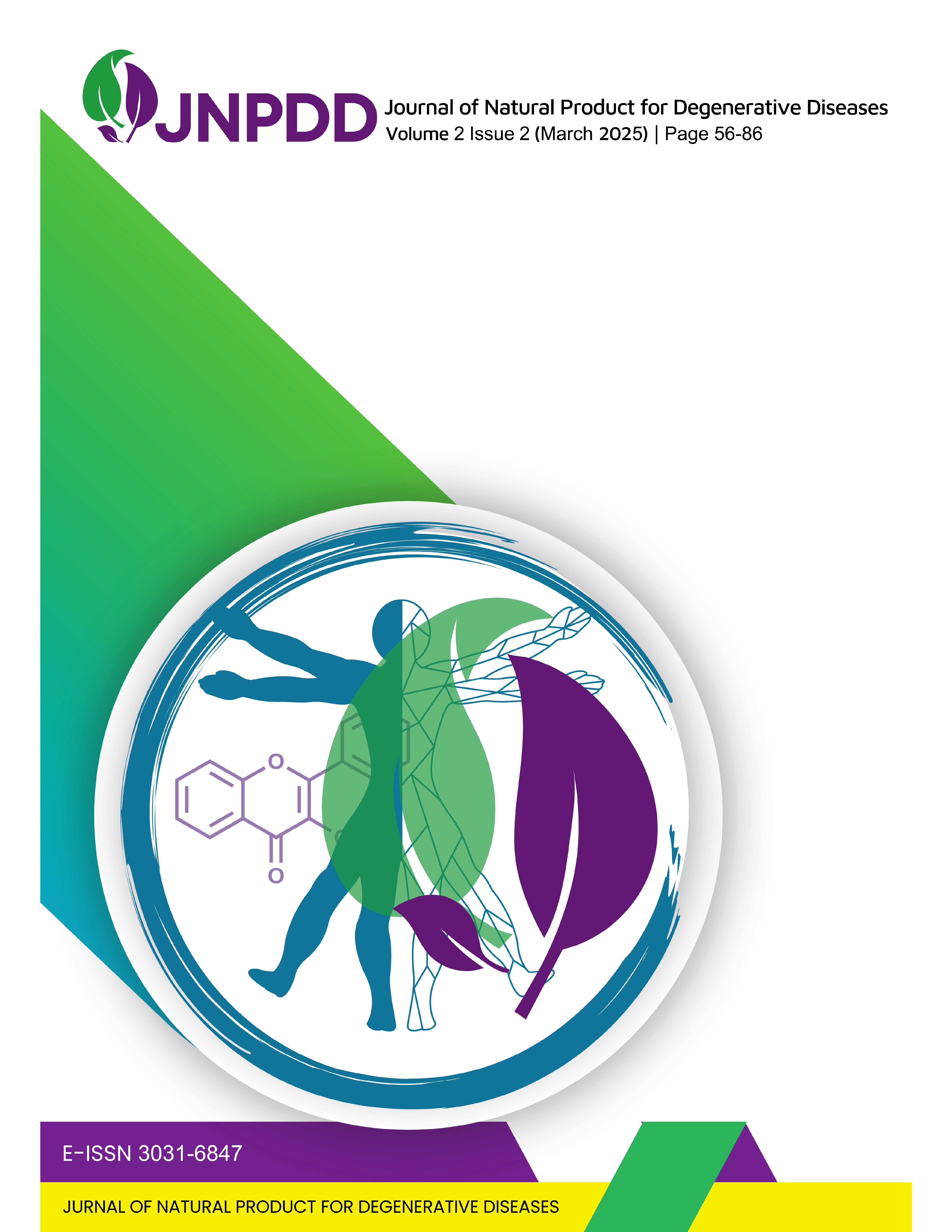Identification of Ethanol Extract Butterfly Pea Flower (Clitoria ternatea) with LC-HRMS and Antioxidant Activity Testing
Abstract views: 14 | PDF downloads: 8
Abstract
Butterfly Pea Flower (Clitoria ternatea) is a plant rich in bioactive compounds, such as flavonoids, anthocyanins, and phenolic compounds, which have the potential to provide health benefits. This study aims to identify active compounds in butterfly pea flower extract and evaluate their antioxidant activity. Compound identification was performed using LC-HRMS is an analytical technique that combines liquid chromatography (LC) with high-resolution mass spectrometry (HRMS), while antioxidant activity was tested using radical scavenging DPPH (2,2-diphenyl-1-picrylhydrazyl). Analytical results showed that butterfly pea flower contain major flavonoid compounds, Butterfly Pea Flower contain compounds glycitein, quercetin, apigenin, kaemferol, laserpitin. The antioxidant activity test showed that Butterfly Pea Flower extract has a weak antioxidant capacity, which has the potential to counteract free radicals and reduce oxidative stress. These findings confirm that butterfly pea flower s have potential as a natural source of antioxidants that can be developed for pharmaceutical and functional food applications.
References
Lijon MB, Meghla NS, Jahedi E, Rahman MA, Hossain I. Phytochemistry and Pharmacological Activities of Clitoria ternatea. Int J Nat Soc Sci [Internet]. 2017;4(1):1–10.
Chayaratanasin P, Barbieri MA, Suanpairintr N, Adisakwattana S. Inhibitory effect of Clitoria ternatea flower petal extract on fructose-induced protein glycation and oxidation-dependent damages to albumin in vitro. BMC Complement Altern Med. 2015;15(1):1–9.
Goh SE, Kwong PJ, NG CL, NG WJ, EE KY. Antioxidant-rich Clitoria ternatea L. flower and its benefits in improving murine reproductive performance. Food Sci Technol. 2021;2061:1–7.
Kamkaen N, Wilkinson JM. The Antioxidant Activity of Clitoria ternatea Flower Petal Extracts and Eye Gel. 2009;(December 2017):28–30.
Tuan Putra TNM, Zainol MK, Mohdisa NS, Mohdmaidin N. Chemical characterization of ethanolic extract of butterfly pea flower (Clitoria ternatea). Food Res. 2021;5(4):127–34.
Jaafar NF, Ramli ME, Salleh RM. Optimum extraction condition of clitorea ternatea flower on antioxidant activities, total phenolic, total flavonoid and total anthocyanin contents. Trop Life Sci Res. 2020;31(2):1–17.
Zakaria NNA, Machin MAB. In vitro protective effects of an aqueous extract of Clitoria ternatea L . flower against hydrogen peroxide ‐ induced cytotoxicity and UV ‐ induced mtDNA damage in human keratinocytes. 2018;(January):1–9.
Arsianti A, Pasha Mahindra S, Nur Azizah N, Megawati Fajrin A, Dameria Nadapdap L. Phytochemical Analysis, Antioxidant and Anticancer Effects of Clitoria ternatae Extract on Breast T47D Cancer Cells. Indones J Med Chem Bioinforma. 2022;1(1).
Nair V, Bang WY, Andarwulan N, Cisneros-zevallos L. Protective Role of Ternatin Anthocyanins and Quercetin Glycosides from Butterfly Pea ( Clitoria ternatea Leguminosae) Blue Flower Petals against Lipopolysaccharide (LPS)-Induced 2017;(June 2015).
Della Vedova L, Ferrario G, Gado F, Altomare A, Carini M, Morazzoni P, et al. Liquid Chromatography–High-Resolution Mass Spectrometry (LC-HRMS) Profiling of Commercial Enocianina and Evaluation of Their Antioxidant and Anti-Inflammatory Activity. Antioxidants. 2022;11(6).
Senyuva HZ, Gökmen V, Sarikaya EA. Future perspectives in OrbitrapTM-high-resolution mass spectrometry in food analysis: a review. Food Addit Contam - Part A Chem Anal Control Expo Risk Assess. 2015;32(10):1568–606
Davinelli S, Bertoglio JC, Polimeni A, Scapagnini G. Cytoprotective Polyphenols Against Chronological Skin Aging and Cutaneous Photodamage. Curr Pharm Des. 2018;24(2):99–105.
Pal D, Dubey P. Flavonoids: A powerful and abundant source of antioxidants. Int J Pharm Pharm Sci. 2013;5(3):95–8.
Lee JH, Mei HC, Kuo IC, Lee TH, Chen YH, Lee CK. Characterizing tyrosinase modulators from the roots of angelica keiskei using tyrosinase inhibition assay and UPLC-MS/MS as the combinatorial novel approach. Molecules. 2019;24(18).
Shim JH. Prostaglandin E2 induces skin aging via E-prostanoid 1 in normal human dermal fibroblasts. Int J Mol Sci. 2019;20(22).
Kendall AC, Kiezel-Tsugunova M, Brownbridge LC, Harwood JL, Nicolaou A. Lipid functions in skin: Differential effects of n-3 polyunsaturated fatty acids on cutaneous ceramides, in a human skin organ culture model. Biochim Biophys Acta - Biomembr [Internet]. 2017;1859(9):1679–89.
Harber KJ, Nguyen TA, Schomakers B V., Heister DAF, de Vries HE, van Weeghel M, et al. Adenine is an anti-inflammatory metabolite found to be more abundant in M-CSF over GM-CSF-differentiated human macrophages. Immunol Lett [Internet]. 2024;265(December 2023):23–30.
Chayaratanasin P, Barbieri MA, Suanpairintr N, Adisakwattana S. Inhibitory effect of Clitoria ternatea flower petal extract on fructose-induced protein glycation and oxidation-dependent damages to albumin in vitro. BMC Complement Altern Med. 2015;15(1):1–9.
Goh SE, Kwong PJ, NG CL, NG WJ, EE KY. Antioxidant-rich Clitoria ternatea L. flower and its benefits in improving murine reproductive performance. Food Sci Technol. 2021;2061:1–7.
Nurcholis W, Iqbal TM, Sulistiyani S, Liwanda N. Profile of Secondary Metabolites in Different Parts of the Butterfly Pea (Clitoria ternatea) Plant with Antioxidant Activity. Yuz Yil Univ J Agric Sci. 2023;33(2):231–47.
Marpaung AM, Andarwulan N, Hariyadi P, Faridah DN. Thermal Degradation of Anthocyanins in Butterfly Pea ( Clitoria ternatea L .) Flower Extract at pH 7. 2017;5(5):199–203.
Jamil N, Naqiuddin M, Zairi M, Nur A, Nasim M, Pa F. Influences of Environmental Conditions to Phytoconstituents in Clitoria ternatea (Butterfly Pea Flower ) –. 2019;(February 2018).
Jeyaraj EJ. Extraction methods of butter fl y pea ( Clitoria ternatea ) flower and biological activities of its phytochemicals. J Food Sci Technol [Internet]. 2020
Molyneux P. The use of the stable free radical diphenylpicryl-hydrazyl (DPPH) for estimating anti-oxidant activity. Songklanakarin J Sci Technol. 2004;26(May):211–9.
Azat Aziz M, Shehab Diab A, Abdulrazak Mohammed A. Antioxidant Categories and Mode of Action. Researchgate. 2019;(April 2020).
Masaki H. Role of antioxidants in the skin: Anti-aging effects [Internet]. Vol. 58, Journal of Dermatological Science. Japanese Society for Investigative Dermatology;2010.p.85–90.




